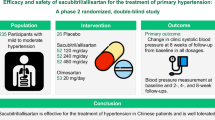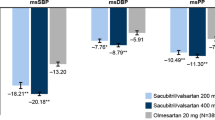Abstract
Objective: To study the efficacy and tolerability of a range of valsartan doses in patients with mild-to-moderate hypertension. Design: 122 adult out-patients were randomised in equal numbers to receive valsartan 10 mg, 40 mg, 80 mg, 160 mg or placebo once daily (OD) for 4 weeks in this multicentre, double-blind, fixed-dose, parallel trial. Patients were assessed at 0, 2 and 4 weeks. Main outcome measures: The primary efficacy variable was change from baseline in trough mean supine diastolic blood pressure (MSuDBP). Other variables included change from baseline in trough mean supine systolic blood pressure (MSuSBP), responder rates and trough/peak ratio. Results: All treatments significantly reduced MSuDBP and MSuSBP at 4-week end-point compared to baseline (P < 0.001). the magnitude of blood pressure lowering was greater with increasing doses of valsartan (least square mean change from baseline for placebo, valsartan 10 mg, 40 mg, 80 mg, 160 mg respectively: msudbp −4.4 mm hg, −4.9 mm hg, −6.5 mm hg, −8.2 mm hg, −9.1 mm hg; msusbp −1.3 mm hg, −3.6 mm hg, −7.0 mm hg, −11.1 mm hg, −11.9 mm hg). a fitted quadratic curve, to predict relationship between dose and change from baseline in trough msudbp, indicated a positive dose response. responder rates were 16%, 24%, 33%, 46%, 54% for placebo, valsartan 10 mg, 40 mg, 80 mg, 160 mg respectively, which also indicated a positive dose response in the dose range of 10 mg to 160 mg. greater than 50% of the antihypertensive effect measured at peak persisted at trough for each of the four active treatment groups, confirming efficacy over a 24-h period. no dose-related adverse experiences were observed, with overall incidence (regardless of relationship to trial medication) of 44% with placebo and 44%, 36%, 22%, 21% for valsartan 10 mg, 40 mg, 80 mg, 160 mg respectively. the most common adverse experience reported was headache which occurred most frequently with placebo (12%). no trial drug-related cough was observed. treatment with valsartan did not produce clinically significant orthostatic changes in diastolic or systolic blood pressure. one case of symptomatic orthostatic hypotension was observed on placebo. Conclusions: The results of this trial show valsartan to effectively lower blood pressure in patients with mild-to-moderate hypertension, and demonstrate that the reduction in blood pressure increases with increasing dose levels.
This is a preview of subscription content, access via your institution
Access options
Subscribe to this journal
Receive 12 digital issues and online access to articles
$119.00 per year
only $9.92 per issue
Buy this article
- Purchase on Springer Link
- Instant access to full article PDF
Prices may be subject to local taxes which are calculated during checkout
Similar content being viewed by others
Author information
Authors and Affiliations
Rights and permissions
About this article
Cite this article
Pool, J., Glazer, R., Chiang, YT. et al. Dose-response efficacy of valsartan, a new angiotensin II receptor blocker. J Hum Hypertens 13, 275–281 (1999). https://doi.org/10.1038/sj.jhh.1000788
Received:
Revised:
Accepted:
Published:
Issue Date:
DOI: https://doi.org/10.1038/sj.jhh.1000788
Keywords
This article is cited by
-
Addressing Orthostatic Hypotension in Heart Failure: Pathophysiology, Clinical Implications and Perspectives
Journal of Cardiovascular Translational Research (2020)
-
Drug-Related Orthostatic Hypotension: Beyond Anti-Hypertensive Medications
Drugs & Aging (2020)
-
Alcohol and psychotropic drugs: risk factors for orthostatic hypotension in elderly fallers
Journal of Human Hypertension (2017)
-
The Pharmacogenomic and Metabolomic Predictors of ACE Inhibitor and Angiotensin II Receptor Blocker Effectiveness and Safety
Cardiovascular Drugs and Therapy (2017)
-
Antihypertensive Medications, Loop Diuretics, and Risk of Hip Fracture in the Elderly: A Population-Based Cohort Study of 81,617 Italian Patients Newly Treated Between 2005 and 2009
Drugs & Aging (2015)



